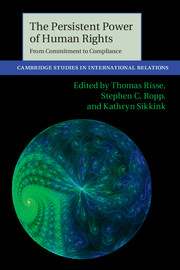Book contents
- Frontmatter
- Contents
- Figures
- Tables
- Contributors
- Preface
- Part I Introduction and stock-taking
- Part II Conceptual and methodological issues
- Part III From ratification to compliance
- Part IV From commitment to compliance
- 11 Encouraging greater compliance
- 12 Business and human rights
- 13 Taming of the warlords
- 14 Changing hearts and minds
- 15 Conclusions
- References
- Index
15 - Conclusions
Published online by Cambridge University Press: 05 March 2013
- Frontmatter
- Contents
- Figures
- Tables
- Contributors
- Preface
- Part I Introduction and stock-taking
- Part II Conceptual and methodological issues
- Part III From ratification to compliance
- Part IV From commitment to compliance
- 11 Encouraging greater compliance
- 12 Business and human rights
- 13 Taming of the warlords
- 14 Changing hearts and minds
- 15 Conclusions
- References
- Index
Summary
The big puzzle for this volume has been how to identify and explain human rights change in the world. Human rights violations continue to be one of the most serious threats to human security, and yet we do not understand fully how to reduce human rights violations. The intellectual and theoretical challenge is first to identify if positive human rights change is happening in the world, that is, are actors moving to greater compliance with international human rights law, and if so, why and how are they doing so. In this conclusion, we return to the main research question of the book: under what conditions and by what mechanisms will actors – states, transnational corporations and other non-state actors – make the move from commitment to compliance with human rights norms? In particular, we will revisit the mechanisms and models of social action and recap the ways in which a more robust consideration of a set of scope conditions for the movement from commitment to compliance contribute to theorizing.
These issues are all the more important because in the last decade the world has witnessed both some of the most important political and institutional developments designed to enhance human rights and it has witnessed some serious setbacks to human rights, in particular 9/11 and later large-scale terrorist attacks and the emergence of a global war on terror framed as an issue where human rights protections had to be set aside. The terrorist attacks on the World Trade Center on September 11, 2011, or the Madrid train bombings in March 2004 can be seen as crimes against humanity, because they were “widespread or systematic attacks” directed against a civilian population, in the language of the Rome Statute. At the same time, the response to 9/11 has led to violations of human rights, including the resurgence of torture, the use of disappearances (“black sites”), kidnapping and refoulement (“extraordinary rendition”) and summary execution (“targeted killings”) by the greatest global power.
- Type
- Chapter
- Information
- The Persistent Power of Human RightsFrom Commitment to Compliance, pp. 275 - 295Publisher: Cambridge University PressPrint publication year: 2013
- 9
- Cited by

